With和without复合结构
初中英语词汇知识点:with的用法全解
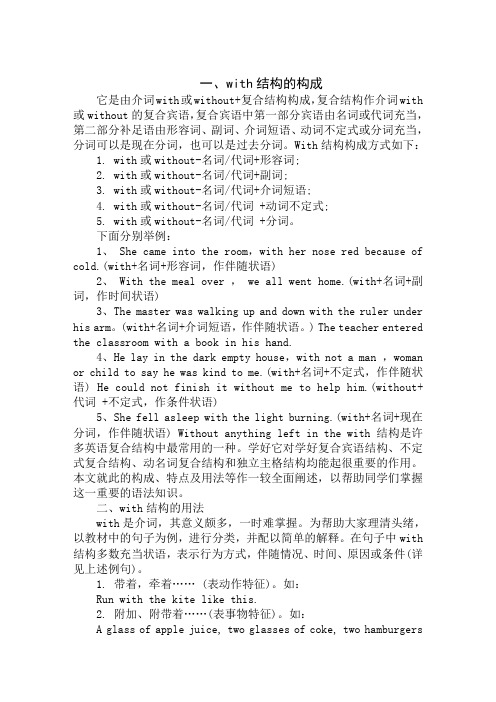
一、with结构的构成它是由介词with或without+复合结构构成,复合结构作介词with 或without的复合宾语,复合宾语中第一部分宾语由名词或代词充当,第二部分补足语由形容词、副词、介词短语、动词不定式或分词充当,分词可以是现在分词,也可以是过去分词。
With结构构成方式如下:1. with或without-名词/代词+形容词;2. with或without-名词/代词+副词;3. with或without-名词/代词+介词短语;4. with或without-名词/代词 +动词不定式;5. with或without-名词/代词 +分词。
下面分别举例:1、 She came into the room,with her nose red because of cold.(with+名词+形容词,作伴随状语)2、 With the meal over , we all went home.(with+名词+副词,作时间状语)3、The master was walking up and down with the ruler under his arm。
(with+名词+介词短语,作伴随状语。
) The teacher entered the classroom with a book in his hand.4、He lay in the dark empty house,with not a man ,woman or child to say he was kind to me.(with+名词+不定式,作伴随状语) He could not finish it without me to help him.(without+代词 +不定式,作条件状语)5、She fell asleep with the light burning.(with+名词+现在分词,作伴随状语) Without anything left in the with结构是许多英语复合结构中最常用的一种。
with结构的构成与用法
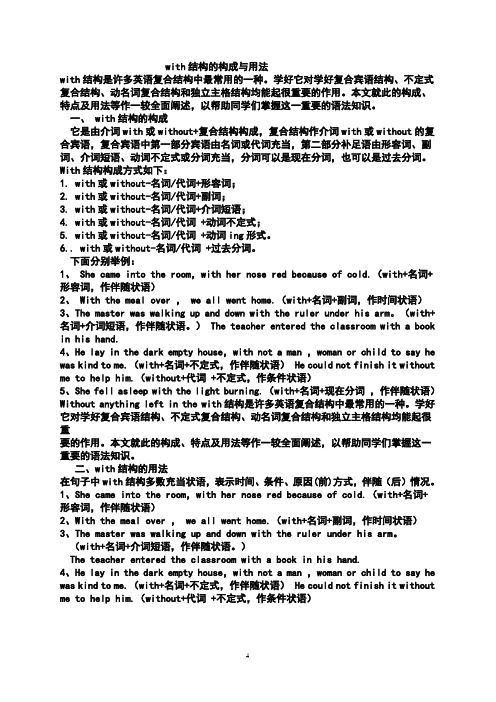
with结构的构成与用法with结构是许多英语复合结构中最常用的一种。
学好它对学好复合宾语结构、不定式复合结构、动名词复合结构和独立主格结构均能起很重要的作用。
本文就此的构成、特点及用法等作一较全面阐述,以帮助同学们掌握这一重要的语法知识。
一、 with结构的构成它是由介词with或without+复合结构构成,复合结构作介词with或without的复合宾语,复合宾语中第一部分宾语由名词或代词充当,第二部分补足语由形容词、副词、介词短语、动词不定式或分词充当,分词可以是现在分词,也可以是过去分词。
With结构构成方式如下:1. with或without-名词/代词+形容词;2. with或without-名词/代词+副词;3. with或without-名词/代词+介词短语;4. with或without-名词/代词 +动词不定式;5. with或without-名词/代词 +动词ing形式。
6.. with或without-名词/代词 +过去分词。
下面分别举例:1、 She came into the room,with her nose red because of cold.(with+名词+形容词,作伴随状语)2、 With the meal over , we all went home.(with+名词+副词,作时间状语)3、The master was walking up and down with the ruler under his arm。
(with+名词+介词短语,作伴随状语。
) The teacher entered the classroom with a book in his hand.4、He lay in the dark empty house,with not a man ,woman or child to say he was kind to me.(with+名词+不定式,作伴随状语) He could not finish it without me to help him.(without+代词 +不定式,作条件状语)5、She fell asleep with the light burning.(with+名词+现在分词,作伴随状语)Without anything left in the with结构是许多英语复合结构中最常用的一种。
高中英语真题-With结构的讲解与训练

With结构的讲解与训练With结构知识要点With结构是许多英语复合结构中最常用的一种。
学好它对学好复合宾语结构、不定式复合结构、动名词复合结构和独立主格结构均能起很重要的作用。
本文就此的构成、特点及用法等作一较全面阐述,以帮助同学们掌握这一重要的语法知识。
1. with结构的构成它是由介词with或without+复合结构构成,复合结构作介词with或without的复合宾语,复合宾语中第一部分宾语由名词或代词充当,第二部分补足语由形容词、副词、介词短语、动词不定式或分词充当,分词可以是现在分词,也可以是过去分词。
With结构构成方式如下:1)with或without-名词/代词+形容词;2)with或without-名词/代词+副词;3)with或without-名词/代词+介词短语;4)with或without-名词/代词 +动词不定式;5)with或without-名词/代词 +分词。
下面分别举例:She came into the room,with her nose red because of cold.(with+名词+形容词,作伴随状语)With the meal over , we all went home.(with+名词+副词,作时间状语)The master was walking up and down with the ruler under his arm。
(with+名词+介词短语,作伴随状语。
) The teacher entered the classroom with a book in his hand.He lay in the dark empty house,with not a man ,woman or child to say he was kind to me.(with +名词+不定式,作伴随状语) He could not finish it without me to help him.(without+代词 + 不定式,作条件状语)She fell asleep with the light burning.(with+名词+现在分词,作伴随状语)Without anything left in the cupboard, she went out to get so mething to eat.(without+代词+过去分词,作为原因状语)2. with结构的用法在句子中with结构多数充当状语,表示行为方式,伴随情况、时间、原因或条件(详见上述例句)。
with的复合结构(基本用法和句法功能)
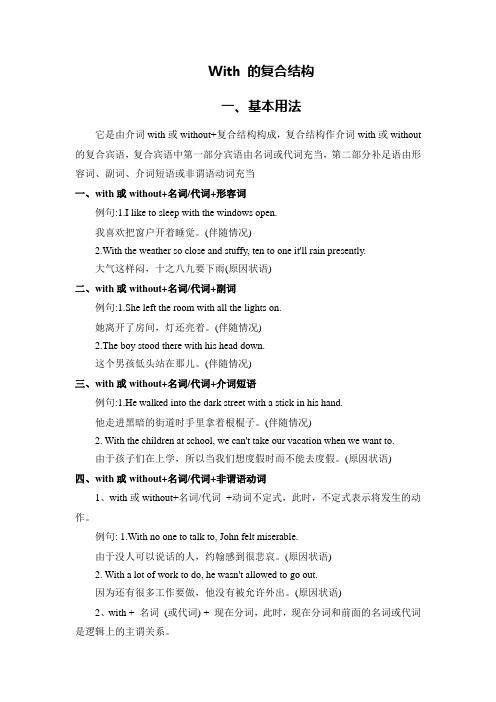
With 的复合结构一、基本用法它是由介词with或without+复合结构构成,复合结构作介词with或without 的复合宾语,复合宾语中第一部分宾语由名词或代词充当,第二部分补足语由形容词、副词、介词短语或非谓语动词充当一、with或without+名词/代词+形容词例句:1.I like to sleep with the windows open.我喜欢把窗户开着睡觉。
(伴随情况)2.With the weather so close and stuffy, ten to one it'll rain presently.大气这样闷,十之八九要下雨(原因状语)二、with或without+名词/代词+副词例句:1.She left the room with all the lights on.她离开了房间,灯还亮着。
(伴随情况)2.The boy stood there with his head down.这个男孩低头站在那儿。
(伴随情况)三、with或without+名词/代词+介词短语例句:1.He walked into the dark street with a stick in his hand.他走进黑暗的街道时手里拿着根棍子。
(伴随情况)2. With the children at school, we can't take our vacation when we want to.由于孩子们在上学,所以当我们想度假时而不能去度假。
(原因状语)四、with或without+名词/代词+非谓语动词1、with或without+名词/代词+动词不定式,此时,不定式表示将发生的动作。
例句: 1.With no one to talk to, John felt miserable.由于没人可以说话的人,约翰感到很悲哀。
(原因状语)2. With a lot of work to do, he wasn't allowed to go out.因为还有很多工作要做,他没有被允许外出。
with的用法有哪些 复合结构用法例句
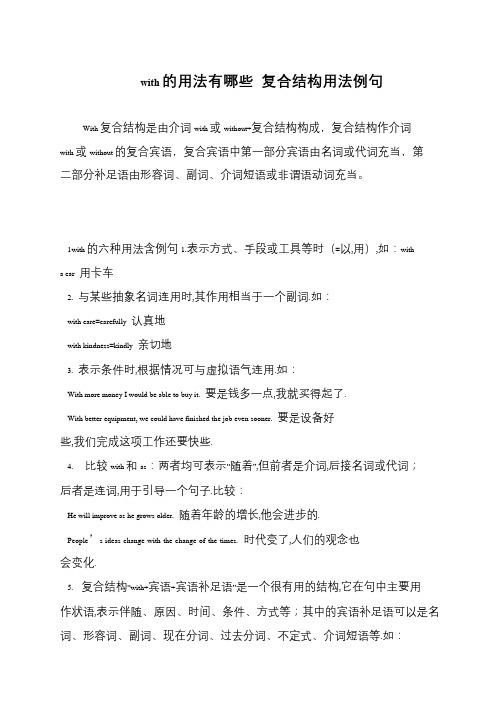
with 的用法有哪些复合结构用法例句
With 复合结构是由介词with 或without+复合结构构成,复合结构作介词
with 或without 的复合宾语,复合宾语中第一部分宾语由名词或代词充当,第
二部分补足语由形容词、副词、介词短语或非谓语动词充当。
1with 的六种用法含例句1.表示方式、手段或工具等时(=以,用),如:with
a car 用卡车
2. 与某些抽象名词连用时,其作用相当于一个副词.如:
with care=carefully 认真地
with kindness=kindly 亲切地
3. 表示条件时,根据情况可与虚拟语气连用.如:
With more money I would be able to buy it. 要是钱多一点,我就买得起了.
With better equipment, we could have finished the job even sooner. 要是设备好些,我们完成这项工作还要快些.
4. 比较with 和as:两者均可表示“随着”,但前者是介词,后接名词或代词;
后者是连词,用于引导一个句子.比较:
He will improve as he grows older. 随着年龄的增长,他会进步的.
People’s ideas change with the change of the times. 时代变了,人们的观念也会变化.
5. 复合结构“with+宾语+宾语补足语”是一个很有用的结构,它在句中主要用
作状语,表示伴随、原因、时间、条件、方式等;其中的宾语补足语可以是名
词、形容词、副词、现在分词、过去分词、不定式、介词短语等.如:。
with复合短语和独立主格结构的区别

一、 with结构的构成它是由介词with或without+复合结构构成,复合结构作介词with或without的复合宾语,复合宾语中第一部分宾语由名词或代词充当,第二部分补足语由形容词、副词、介词短语、动词不定式或分词充当,分词可以是现在分词,也可以是过去分词。
With结构构成方式如下:1. with或without-名词/代词+形容词;2. with或without-名词/代词+副词;3. with或without-名词/代词+介词短语;4. with或without-名词/代词 +动词不定式;5. with或without-名词/代词 +分词。
下面分别举例:1、 She came into the room,with her nose red.(with+名词+形容词,作伴随状语)2、 With the meal over , we all went home.(with+名词+副词,作时间状语)3、The master was walking up and down with the ruler under his arm。
(with+名词+介词短语,作伴随状语。
) The teacher entered the classroom with a book in his hand.4、He lay in the dark empty house,without a man ,woman or child to say he was kind to me.(with+名词+不定式,作伴随状语) He could not finish it without me to help him.(without+代词 +不定式,作条件状语)5、She fell asleep with the light burning.(with+名词+现在分词,作伴随状语)6. Without anything left in the cupboard, she went out to get something to eat.(without+代词+过去分词,作为原因状语)二、with结构的用法在句子中with结构多数充当状语,表示行为方式,伴随情况、时间、原因或条件(详见上述例句)。
雅思阅读语法10--with和without的复合结构

(2)作原因状语 With the key lost, she could not enter the room.
=As/Because the key had been lost, she could not enter the room.
(3)作条件状语 With time permitting, we`ll visit the Summer Palace. =If time permits, we`ll visit the Summer Palace.
4.他们建立了一支足球队,汤姆当队长。
They set up a football team, with Tom their head.
5. 那个小偷被带进来,双手被绑在后面。
The thief was brought in, with his hands tied back.
6. 因为有太多的作业要做,所以我们不能出 去玩。
5.充当定语
The road with fruit trees planted on both sides leads to the mountain village.
两边果树的那条路通向那个山村。 The room with lights on is our class-room .
开着灯的那个教室是我们的。
父母不在,汤姆变得更淘气。
2. with + 宾语 + 形容词 With the door and windows open wide, the room was very cold. 门窗大开,屋内很冷。
With her parents dead, the girl had to left school. 她父母死了,那女孩只好辍学。
with(without)复合短语和独立主格结构的区别
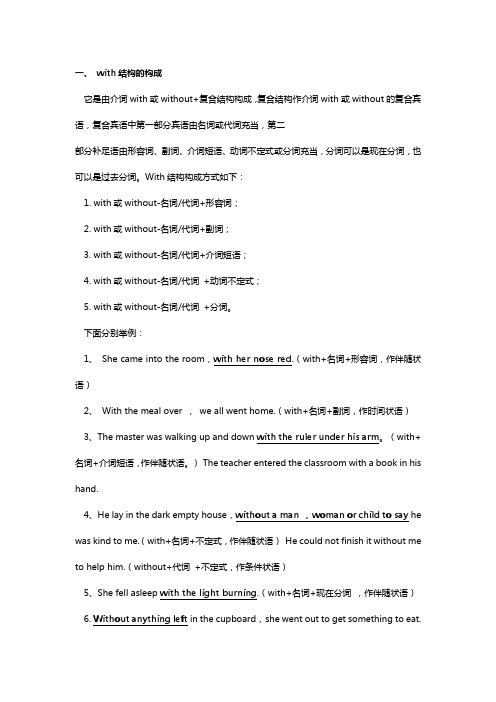
一、with结构的构成它是由介词with或without+复合结构构成,复合结构作介词with或without的复合宾语,复合宾语中第一部分宾语由名词或代词充当,第二部分补足语由形容词、副词、介词短语、动词不定式或分词充当,分词可以是现在分词,也可以是过去分词。
With结构构成方式如下:1. with或without-名词/代词+形容词;2. with或without-名词/代词+副词;3. with或without-名词/代词+介词短语;4. with或without-名词/代词+动词不定式;5. with或without-名词/代词+分词。
下面分别举例:1、She came into the room,with her nose red.(with+名词+形容词,作伴随状语)2、With the meal over ,we all went home.(with+名词+副词,作时间状语)3、The master was walking up and down with the ruler under his arm。
(with+名词+介词短语,作伴随状语。
)The teacher entered the classroom with a book in his hand.4、He lay in the dark empty house,without a man ,woman or child to say he was kind to me.(with+名词+不定式,作伴随状语)He could not finish it without me to help him.(without+代词+不定式,作条件状语)5、She fell asleep with the light burning.(with+名词+现在分词,作伴随状语)6. Without anything left in the cupboard,she went out to get something to eat.(without+代词+过去分词,作为原因状语)二、with结构的用法在句子中with结构多数充当状语,表示行为方式,伴随情况、时间、原因或条件(详见上述例句)。
妙记8 言简意明的非谓语动词和withwithout复合结构
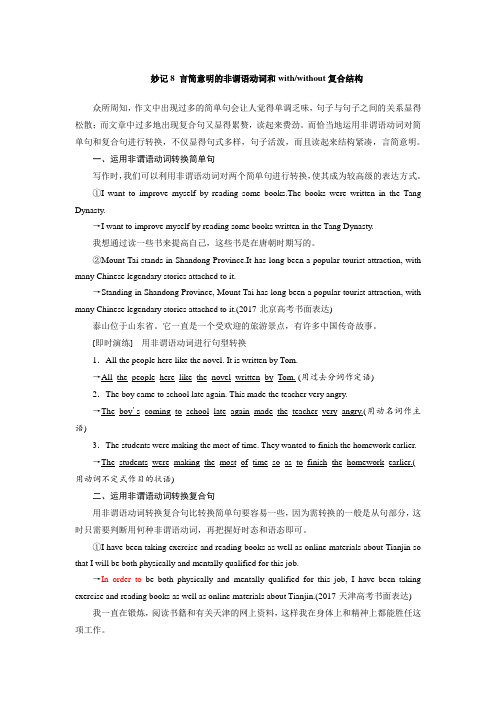
妙记8 言简意明的非谓语动词和with/without复合结构众所周知,作文中出现过多的简单句会让人觉得单调乏味,句子与句子之间的关系显得松散;而文章中过多地出现复合句又显得累赘,读起来费劲。
而恰当地运用非谓语动词对简单句和复合句进行转换,不仅显得句式多样,句子活泼,而且读起来结构紧凑,言简意明。
一、运用非谓语动词转换简单句写作时,我们可以利用非谓语动词对两个简单句进行转换,使其成为较高级的表达方式。
①I want to improve myself by reading some books.The books were written in the Tang Dynasty.→I want to improve myself by reading some books written in the Tang Dynasty.我想通过读一些书来提高自己,这些书是在唐朝时期写的。
②Mount Tai stands in Shandong Province.It has long been a popular tourist attraction, with many Chinese legendary stories attached to it.→Standing in Shandong Province, Mount Tai has long been a popular tourist attraction, with many Chinese legendary stories attached to it.(2017·北京高考书面表达)泰山位于山东省。
它一直是一个受欢迎的旅游景点,有许多中国传奇故事。
[即时演练]用非谓语动词进行句型转换1.All the people here like the novel. It is written by Tom.→All_the_people_here_like_the_novel_written_by_Tom. (用过去分词作定语)2.The boy came to school late again. This made the teacher very angry.→The_boy's_coming_to_school_late_again_made_the_teacher_very_angry.(用动名词作主语)3.The students were making the most of time. They wanted to finish the homework earlier.→The_students_were_making_the_most_of_time_so_as_to_finish_the_homework_earlier.(用动词不定式作目的状语)二、运用非谓语动词转换复合句用非谓语动词转换复合句比转换简单句要容易一些,因为需转换的一般是从句部分,这时只需要判断用何种非谓语动词,再把握好时态和语态即可。
初中英语词汇知识点:with的用法全解
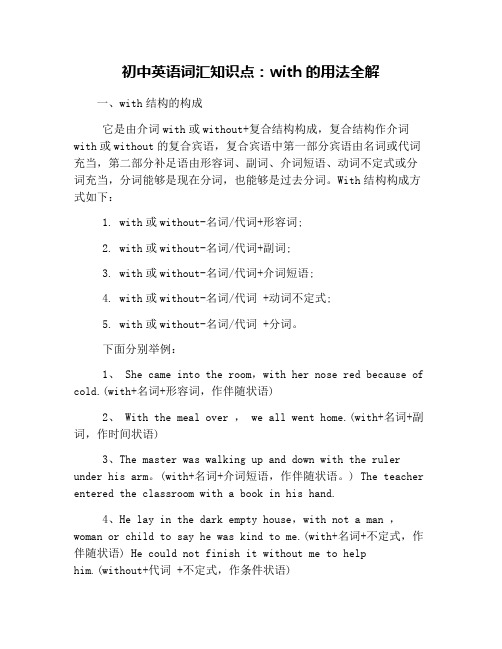
初中英语词汇知识点:with的用法全解一、with结构的构成它是由介词with或without+复合结构构成,复合结构作介词with或without的复合宾语,复合宾语中第一部分宾语由名词或代词充当,第二部分补足语由形容词、副词、介词短语、动词不定式或分词充当,分词能够是现在分词,也能够是过去分词。
With结构构成方式如下:1. with或without-名词/代词+形容词;2. with或without-名词/代词+副词;3. with或without-名词/代词+介词短语;4. with或without-名词/代词 +动词不定式;5. with或without-名词/代词 +分词。
下面分别举例:1、 She came into the room,with her nose red because of cold.(with+名词+形容词,作伴随状语)2、 With the meal over , we all went home.(with+名词+副词,作时间状语)3、The master was walking up and down with the ruler under his arm。
(with+名词+介词短语,作伴随状语。
) The teacher entered the classroom with a book in his hand.4、He lay in the dark empty house,with not a man ,woman or child to say he was kind to me.(with+名词+不定式,作伴随状语) He could not finish it without me to helphim.(without+代词 +不定式,作条件状语)5、She fell asleep with the light burning.(with+名词+现在分词,作伴随状语) Without anything left in the with结构是很多英语复合结构中最常用的一种。
雅思阅读语法10--with和without的复合结构

◆with和without复合结构与状语从句的转化
Ⅰ) with和without复合结构在句中作状语时,一般可变为状 语从句。 (1)作时间状语
With winter coming on, the trees turn yellow and some birds fly south. = When winter comes on, the trees turn yellow and some birds fly south.
With the teacher standing beside, she felt a bit uneasy . 老师站在旁边,她觉得有点不自然。
6.with + 宾语 + 过去分词 (动宾关系) With the work done, she felt greatly relieved. 工作完成了,她大大地松了一口气。 With his hair cut, he looks much younger.
4.他们建立了一支足球队,汤姆当队长。
They set up a football team, with Tom their head.
5. 那个小偷被带进来,双手被绑在后面。
The thief was brought in, with his hands tied back.
6. 因为有太多的作业要做,所以我们不能出 去玩。
理了头发,他显得年轻多了。
7.with + 宾语 + 不定式 (将要发生) With her to go with us, we're sure to have a pleasant journey. 有她和我们一起去,我们的旅途一定会很愉 快。 With Mr. Smith to teach them English next term, they will be greatly improved in spoken English. 下学期史密斯先生教他们英语,他们的口语 会大有提高。
独立主格结构和with复合结构

(5)名词/代词+to do,强调逻辑主语与 不定式之间是主谓关系,且强调的是一次 性动作。 eg: We said goodbye to each other, one to go home, the other to go to the bookstore.
二.With和without复合结构 (又叫独立主格结构)
◆作状语,表示时间、伴随、方式、原因、结果等 With/without + n. /pron. + n. With/without + n. /pron. + adj. with /without + n. /pron. + adv. with /without + n. /pron. + prep. with /without + n. /pron. + doing with /without + n. /pron. + being done with /without + n. /pron. + done with /without + n. /pron. + to do
With a lot of difficult problems __, the newly-elected president is having a hard time. A. settled B. settling C. to settle D. being settled
__ production up by 60%, the company has had another excellent year. A. As B. For C. With D. Through
1)with/without + n./pron. + n.
with和without的用法
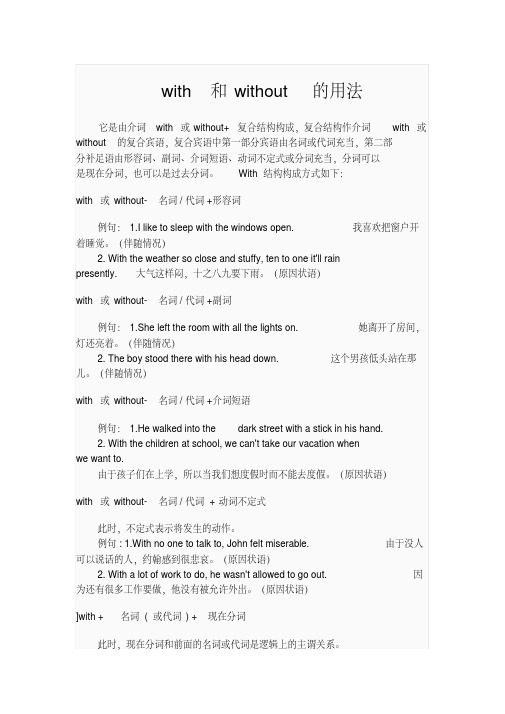
with和 without的用法它是由介词with或without+复合结构构成,复合结构作介词with或without的复合宾语,复合宾语中第一部分宾语由名词或代词充当,第二部分补足语由形容词、副词、介词短语、动词不定式或分词充当,分词可以是现在分词,也可以是过去分词。
With结构构成方式如下:with或without-名词/代词+形容词例句:1.I like to sleep with the windows open. 我喜欢把窗户开着睡觉。
(伴随情况)2. With the weather so close and stuffy, ten to one it'll rainpresently. 大气这样闷,十之八九要下雨。
(原因状语)with或without-名词/代词+副词例句:1.She left the room with all the lights on.她离开了房间,灯还亮着。
(伴随情况)2. The boy stood there with his head down. 这个男孩低头站在那儿。
(伴随情况)with或without-名词/代词+介词短语例句:1.He walked into the dark street with a stick in his hand.2. With the children at school, we can't take our vacation whenwe want to.由于孩子们在上学,所以当我们想度假时而不能去度假。
(原因状语)with或without-名词/代词 +动词不定式此时,不定式表示将发生的动作。
例句: 1.With no one to talk to, John felt miserable. 由于没人可以说话的人,约翰感到很悲哀。
(原因状语)2. With a lot of work to do, he wasn't allowed to go out. 因为还有很多工作要做,他没有被允许外出。
1独立主格结构和with复合结构复习[课件]
![1独立主格结构和with复合结构复习[课件]](https://img.taocdn.com/s3/m/c4530e55df80d4d8d15abe23482fb4daa58d1d0b.png)
the post office .
5. ________to the left , and you'll find
the post office .
• A. Turning B. To turn C. Turn D. Turned
• 二、分析逻辑主语 确定要选非谓语动词之后,第二步要分析其逻 辑主语。非谓语动词虽不能作谓语,但仍具有 动词特点,其逻辑上的动作执行者就叫做逻辑 主语。非谓语动词作状语时,其逻辑主语须和 句子的真正主语一致。若不一致,则须加上自 己的逻辑主语。 1. ________no buses , we have to walk home .
=Here are the first three volumes and the fourth one is coming out next month.
(Ⅱ) with和without复合结构可以作 后置定语修饰名词,而独立主格结
构则不可作后置定语修饰名词。
Soon she arrived at a park with grass green and flowers in blossom.
1. ______from space , the earth looks blue .
2.______from space , we can see the earth is blue .
• A. Seen B. Seeing C. To see D.See 3. The dirty clothes ______ , the girl hung them up outside . 4. _____ the dirty clothes ,the girl hung them up outside .
With复合结构的用法小结
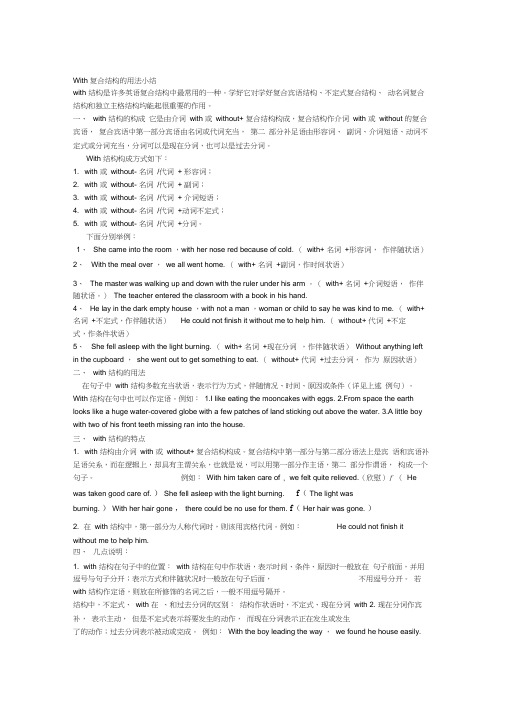
With 复合结构的用法小结with 结构是许多英语复合结构中最常用的一种。
学好它对学好复合宾语结构、不定式复合结构、动名词复合结构和独立主格结构均能起很重要的作用。
一、with 结构的构成它是由介词with 或without+ 复合结构构成,复合结构作介词with 或without 的复合宾语,复合宾语中第一部分宾语由名词或代词充当,第二部分补足语由形容词、副词、介词短语、动词不定式或分词充当,分词可以是现在分词,也可以是过去分词。
With 结构构成方式如下:1. with 或without- 名词/代词+ 形容词;2. with 或without- 名词/代词+ 副词;3. with 或without- 名词/代词+ 介词短语;4. with 或without- 名词/代词+动词不定式;5. with 或without- 名词/代词+分词。
下面分别举例:1、She came into the room ,with her nose red because of cold. (with+ 名词+形容词,作伴随状语)2、With the meal over ,we all went home. (with+ 名词+副词,作时间状语)3、The master was walking up and down with the ruler under his arm 。
(with+ 名词+介词短语,作伴随状语。
)The teacher entered the classroom with a book in his hand.4、He lay in the dark empty house ,with not a man ,woman or child to say he was kind to me. (with+ 名词+不定式,作伴随状语)He could not finish it without me to help him. (without+ 代词+不定式,作条件状语)5、She fell asleep with the light burning. (with+ 名词+现在分词,作伴随状语)Without anything left in the cupboard ,she went out to get something to eat. (without+ 代词+过去分词,作为原因状语)二、with 结构的用法在句子中with 结构多数充当状语,表示行为方式,伴随情况、时间、原因或条件(详见上述例句)。
小议“介词withwithout的复合结构”

外语教学与研究2016.06“with/without 的复合结构”是英语复合结构中最常见的一种,在文学作品和中学英语教材中这个结构也屡见不鲜。
因此,了解、掌握它的用法,探讨结构内在的联系,对英语学习者准确理解教材,提高写作和阅读能力大有裨益。
1.基本构成及特点with/without+复合宾语结构,复合宾语的第一部分作介词with/without 的宾语,由名词或代词构成,第二部分是宾语补足语,由名词、形容词、副词、介词以及非谓语动词构成。
该结构有以下三个特点:(1)逻辑主语(with/without 之后的名词或代词)与句子的主语不同,它独立存在;(2)名词或代词与后面的名词、形容词、副词、介词以及非谓语动词构成逻辑上的主谓关系;(3)常用逗号与主句分开,对主句的内容进行补充或者描述。
2.基本形式(1)with/without +名词(代词)+名词。
With Mr.Smith our group leader ,we arrived at the destination as planned.(2)with/without +名词(代词)+形容词。
Lenin fell asleep with the door open.(3)with/without +名词(代词)+副词。
The naughty boy stood before his father ,with his head down.(4)with/without +名词(代词)+介词短语。
With the children at home,the parents can ’t take our holiday when they want to.(5)with/without +名词(代词)+V-ing 。
With prices going up so rapidly,people can ’t afford the lux⁃uries.(6)with/without +名词(代词)+V-ed 。
- 1、下载文档前请自行甄别文档内容的完整性,平台不提供额外的编辑、内容补充、找答案等附加服务。
- 2、"仅部分预览"的文档,不可在线预览部分如存在完整性等问题,可反馈申请退款(可完整预览的文档不适用该条件!)。
- 3、如文档侵犯您的权益,请联系客服反馈,我们会尽快为您处理(人工客服工作时间:9:00-18:30)。
1.I couldn't do my homework with all going that noise ______(go) on. 3.It was a pity that the great writer died unfinished with his work ________(finish). 4.I send you 100 dollars today, with the rest _______(follow) in a year. to follow 6.The lorry with apples ________(load) loaded on belongs to me. 7.With all the factors ________(consider), this project is a considered good one.
3. with+宾语+副词 The girl fell asleep with the light on. 那位女孩睡着了,灯还亮着。 Her mother sat in a chair with her head (bent) down. 她母亲坐在椅子上,头低着。 4. with+宾语+不定式 I can’t go out with these clothes to wash. 因为这些衣服要洗,我不能出去。 I have to go to bed with nothing to do. 我没有事可做,只好睡觉。
(1) On Sundays there were a lot of children playing in the park, ____ parents were seated together joking. A. their B. whose C. which D. that (2) On Sundays there were a lot of children playing in the park, and _________ parents were seated together joking. • A. their B. whose C. which D. that
• 定语从句 • He is the person who has a lot of problems to settle.
• He is the person with a lot of problems to settle.
• He is the person having a lot of problems to settle.
没人注意,他从后门溜走了。(slip out) Without anyone noticing, he slipped out from the back door.
with复合结构与独立主格结构
After the work was done, he went home.
The work done, he went home. With the work done, he went home. 独立主格结构大多可由with复合结构省略 with变化而来
On Sundays there were a lot of children playing in the park, _________ parents seated together joking. A. their B. whose C. which D. that
【分析】最佳答案是A。与上面一题相似, their parents seated together joking 不是非 限制性定语从句,而是一个独立主格结构, 因为空格后的动词 seated 不是谓语,而是 一个过去分词,因为 seat 作动词用时,是及 物动词。
With 复合结构 with和without 复合结构是: with/without+名词/代词+分词 /不定式/形容词/副词/介词短 语。在句子中可以作状语或定语。
现将with复合结构的构成和用法归纳如下:
1. with+宾语+名词 He died with his daughter still a school girl. 他死的时候,他的女儿还是个学生。 2. with+宾语+形容词 He used to sleep with all the windows open. 他过去常常开着窗子睡觉。
with复合结构的语义逻辑
1. 表示伴随状况 She left the office with tears in her eyes. 她眼里含着泪,离开了办公室。
She left the office and there were tears in her eyes.
2. 表示原因
Because his key was lost, he couldn’t get into the office. With his key lost, he couldn”t get into the office. 由于钥匙丢了,他进不了办公室。
5. 表示结果
The battle ended and the enemy was defeated. The battle ended with the enemy defeated. 战斗结束了,敌人被打败了。
without 的复合结构
无话可说,他离开了教室。 Without any word to say, he left the classroom.
用过去分词表示被动或已完成的动作。 In the reading room, we found her seated at a desk, with her attention __ on a book. A. fixing B. fixes C. fixed D. to fix
with/without+名词%, the company has had another excellent year. A. As B. For C. With D. Through
5.The weather __ so bad, we had to put off the football match. A. was B. is C. were D. being
7. The boy lay on the ground, his eyes __ and his hands __. A. being closed; trembling B. closed; trembling C. closed; trembled D. closing; trembled
3. 表示时间 After the problem was settled, the meeting was over/ended.
The meeting was over with the problem settled.
问题解决以后,会议结束了。
4. 表示条件
If time permits, I’d like to see the new film. I’d like to see the new film with time permitting. 如果时间许可,我想看那部新电影。
Soon she arrived at a park with grass green and flowers in blossom. = Soon she arrived at a park where the grass was green and where the flowers were in blossom.
巩固练习
1.__ ten minutes __ before the last train left, we arrived at the station on time. A. There were; to go B. With; to go C. I was; left D. It had; left 2.The lady said she would buy a gift for her daughter with the __. A.20 dollars remained B.20 dollars to remain C. remained 20 dollars D. remaining 20 dollars
(5) On Sundays there were a lot of children playing in the park, _________ parents were sitting together joking. A. their B. whose • C. which D. that
9.Weather __, the sports meet will be held as scheduled. A. permits B. will permit C. to permit D. permitting 10.__ a rainy day, he didn`t go out for a walk as usual. A. It was B. It is C. It being D. Having been
7. with+宾语+过去分词 With the weather changed, we decided to put off the sports meet. 由于天气变了,我们决定推迟举行运动会
He lay on his back, with his teeth set and his eyes closed. 他仰卧着,咬着牙、闭着眼。
5. with+宾语+介词短语 The teacher came in with a book in his hand. 老师进来了,手里拿着本书。
6. with+宾语+现在分词 I can’t finish the work on time with these children playing around. 有这些孩子们在周围玩耍,我无法按时完成 工作。
